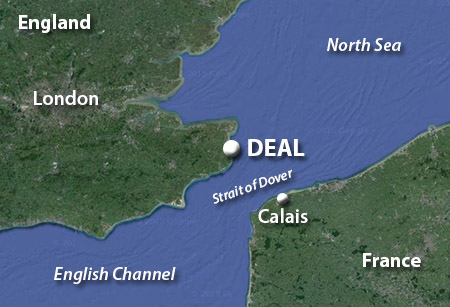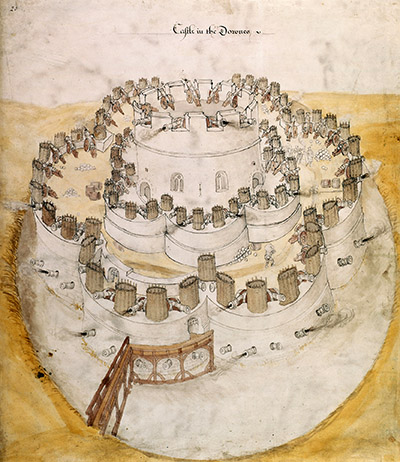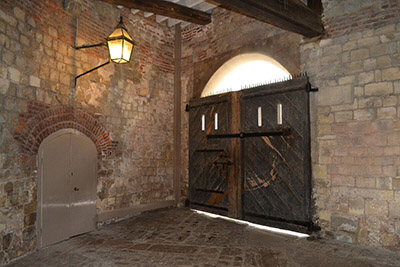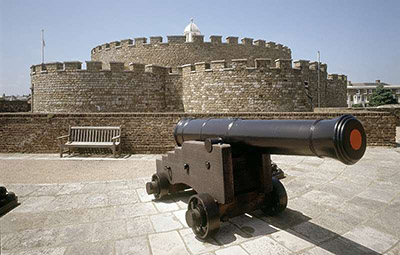 |
Deal Castle
Deal, Kent, UK
|
|
 |
Constructed: 1539-1540
Used by: England
Conflict in which it participated:
English Civil War
|
Deal Castle is not a starfort, but nor is it truly a castle. It's a device fort, England's early attempt to address the surging technology of artillery.
England's King Henry VIII (1491-1547) had a "great matter." He needed a live male heir, but his wife, Catherine of Aragon (1485-1536) seemed obstinately determined to bear him only live females and dead males. |
 |
 |
|
The resulting brouhaha, in which Henry initiated the English Reformation and rejected Papal authority in order to be granted an annulment from Catherine, wasn't perhaps as self-centered as one might imagine. In England's recent history, kings dying without leaving a male heir had tended to lead to bloodshed over whom should rightfully take his place. Plus, we have Henry's "great matter" to thank for the development of the device fort.
|

The official drawing of the proposed Deal Castle, which was designed by German engineer Stephan von Haschenperg. This drawing was presented to Henry VIII for approval in 1539. He must have liked what he saw, because construction began later that year. |
 |
One of the results of Henry separating England from the Catholic church was the immediate enmity of France and Spain. It seemed clear that either or both would imminently be landing on England's shores in order to return the English to the Catholic fold by stabbing all of them to death...but in addition to their many and varied blades, the armies of those angry Catholic kingdoms would be coming with artillery.
In 1494, a French army, led by King Charles VIII (1470-1498), had invaded Italy. The French army included the first siege train to include artillery, which spurred the development of the starfort in northern Italy during this period: The castles and fortifications of old were no match for thoughtfully-applied artillery.
When Henry imagined the coming onslaught 35 years later, he surely expected to be attacked with this latest of military technologies, and thus set his engineers towards the development of modern fortifications that could both defend against, and utilize, plenty of cannons. While in Italy the solution was to make forts with pointy bastions protecting curtain walls, in England it was to make pretty concentric circles. |
|
|
Some aspects of the device fort are similar to those of a starfort: The projecting bastions, squat and compact stature, surrounding ditch and angled slopes are all shared traits. There, however, the similarities end...but ultimately, a device fort is an artillery fort, which is what the starfort was invented to be.
Another result of Henry's rejection of Catholicism was the Dissolution of the Monasteries. This was the process by which all Catholic monasteries, priories, convents and friaries in England, Wales and Ireland were closed, their assets appropriated by the crown. Deal Castle was built with local brick and Caen stone, building materials made available by the tearing down of monasteries: Timely and fortuitous!
|
Deal is located on England's southeastern coast, in an area known as the Downs, about halfway betwixt Dover and the Thames River Estuary. The Downs is a somewhat sheltered stretch of sea, with deep anchorages and easy landing areas...plus it's just about as close as one can get to mainland Europe. Adding all of these factors together made it seem pretty obvious to Henry where an invasion force setting out from France would land.
|
 |
 Deal Castle may not be a starfort, but it's got one heck of a cool ditch. Deal Castle may not be a starfort, but it's got one heck of a cool ditch. |
|
The 1539 Device Programme, and a second round in 1544, resulted in around 30 fortifications built along England's southern coast. These ranged in size and complexity, including earthen bulwarks, blockhouses, device forts and, during the 1544 programme, some forts that embraced the "Italian style," which of course means starforts. One fort of the period that seems to have utilized both styles was Pendennis Castle, at Falmouth, Cornwall. |
 The "entrance courtyard" of Deal Castle's main gate. The "entrance courtyard" of Deal Castle's main gate. |
 |
Deal Castle is one of three such forts that were built within two miles of one another to dominate the Downs: Wilmer Castle to the south and Sandown to the north, both smaller device forts, were connected to Deal Castle with communications ditches. That all of these huge, state-of-the (-English-) art fortifications were built in a single year was a testament to Henry's determination!
The more alert amongst us will have noted the castle-like embrasures along the edges of Deal Castle's top two tiers. It is thought that these embrasures were actually added, as decorations, in the 18th century.
|
|
|
The initial idea was that cannon along these tiers would need complete freedom of movement in order to track sailing ships, while it was thought that those ships' return fire would be been inaccurate enough to make such embrasures unnecessary to protect the fort's gun crews. Plus, they're just gun crews. Stephan von Haschenperg's initial drawing of Deal Castle clearly illustrated such embrasures only on the fort's top tier, with temporary fascines scattered liberally along the rest of the tiers. Surely bunches of sticks would have afforded plenty of protection to the dudes who manned the guns.
|
Sadly, the expected French 'n' Spanish invasion never occurred. Deal Castle continued to be manned as though it were an actual strategic asset, despite the fact that England's engineers had woken up and smelt the cappuccino before the beginning of the second Device Programme, and recognized the Trace Italienne (starfort) to be the ultimate fortification concept.
Deal Castle finally got to see some action (of a sort) in 1648, though not against the enemy for which it had been intended. As part of the ongoing English Civil War, Royalist troops captured all three of the device forts at Deal, and were only ejected after several months' siege by Parliamentarian forces.
|
 |
 See? Embrasures. And a gun that maintains its youthful glow by consuming a steady diet of oranges. See? Embrasures. And a gun that maintains its youthful glow by consuming a steady diet of oranges. |
|
Though Deal Castle was kept relatively current and ready for action, none other was forthcoming. During the Second World War (1939-1945), the Luftwaffe, for some reason, determined that Deal Castle was worthy of bombing. At least one hit was achieved, destroying the fort's Captain's House: This was the quarters of Deal Castle's commanding officer, who had the foresight to not be in his house at the time.
|
 The Tudor Rose. Oh no, you don't. The Tudor Rose. Oh no, you don't. |
 |
One of the myths about Deal Castle was that its distinctive design came about in order to make it resemble the Tudor Rose, the traditional floral heraldic emblem of the House of Tudor (which was the family from whence all of England's monarchs came from 1485 to 1603).
This seems highly unlikely, which is not to say downright silly. Not only does Deal Castle not particularly look like the Tudor Rose, there's no reason to think that such an important fortification would be designed with anything other than practicality in mind. If we were talking about the Spanish, who were known for a semi-ridiculous affinity for the ornamental as related to their fortifications, I could believe a fort shaped like a flower. |
|
|
Today, Deal Castle is open to the public for a very reasonable-seeming entrance fee of £3. Thanks to Soloner.org for many of the cool pictures utilized on this page!
|
|
|
|
|
|
|
 |




